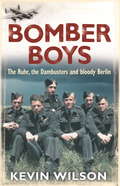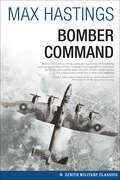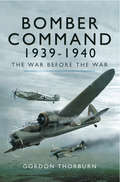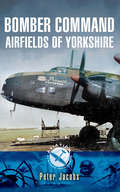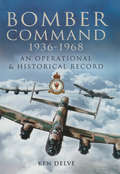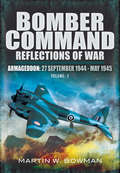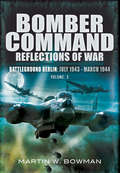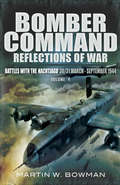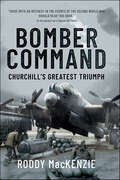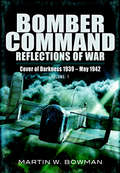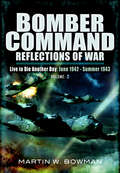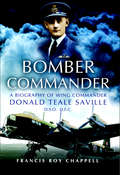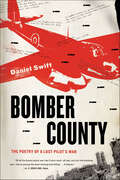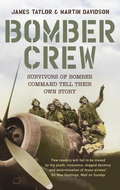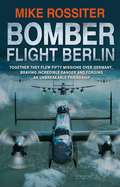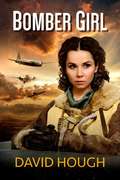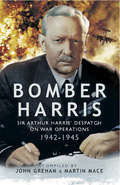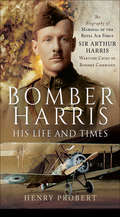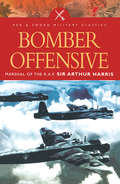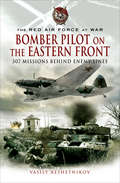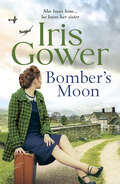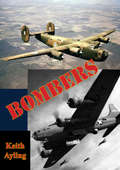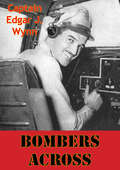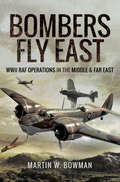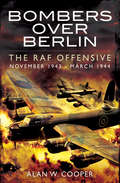- Table View
- List View
Bomber Boys: The Raf Offensive Of 1943 (Wn Military Ser.)
by Kevin WilsonA gripping account of the everyday heroism of British bomber crews in 1943 - the year when Bomber Command believed it could win WWII by bombing alone.In 1943 the RAF began a bombing campaign against Germany, the like of which had never before been seen. Over the next twelve months, tens of thousands of aircrews flew across the North Sea to drop their bombs on German cities. They were opposed not only by the full force of the Luftwaffe, but by a nightmare of flak, treacherously icy conditions, and constant mechanical malfunction. Most of these crews never finished their tour of operations but were either shot down and killed, or taken prisoner by an increasingly hostile enemy.This is the story of the everyday heroism of British bomber crews in the days when it was widely believed that the Allies could win the Second World War by bombing alone. Kevin Wilson has interviewed hundreds of former airmen about what their lives were like in 1943: the stomach-churning tension of flying repeatedly over hostile territory, the terror at being shot down or captured, and the peculiar mixture of guilt and pride at unleashing such devastation on Germany.
Bomber Command
by Max HastingsThis award-winning classic of WWII military history chronicles the Royal Air Force’s bombing campaign against Germany.RAF Bomber Command’s air offensive against the cities of Nazi Germany was one of the most epic campaigns of World War II. The struggle began meekly in 1939 with only a few aircraft—Whitleys, Hampdens, and Wellingtons—flying blindly through the night on their ill-conceived bombing runs. It ended six years later with 1,600 Lancasters, Halifaxes, and Mosquitoes, equipped with the best of British wartime technology, blazing whole German cities in a single night. In Bomber Command, originally published to critical acclaim in the UK, famed British military historian Sir Max Hastings offers a captivating analysis of the strategy and decision-making behind one of World War II’s most violent episodes. With firsthand descriptions of the experiences of aircrew from 1939 to 1945—based on one hundred interviews with veterans—and a harrowing narrative of the experiences of Germans on the ground during the September 1944 bombing of Darmstadt, Bomber Command is widely recognized as a classic account of one of the bloodiest campaigns in World War II history.Winner of the Somerset Maugham Prize
Bomber Command 1939–1940: The War before the War
by Gordon ThorburnFor Bomber Command, the term 'Phoney War' never really meant much. Five Blenheims of 107 Squadron were among the blood and bullets the day after war was declared and only one came back.On 14 December 1939, in a disastrous raid on shipping, 99 Squadron lost six Wellingtons with only three survivors out of thirty-six crew. Even worse, in the biggest air battle so far, 18 December, Wilhelmshaven, five Wellingtons of 9 Squadron went down, four of 37 Squadron and two of 149 Squadron.Bomber Command lost sixty-eight aircraft and crews in action in the four war months of 1939, and a further seventy-eight in accidents. In the months up to the French surrender, losses rose spectacularly as the Germans triumphed wherever they went. In a few hours on 14 May, resisting the Blitzkrieg, forty-seven Fairey Battles and Bristol Blenheims were shot from the sky. Through the Scandinavian defence, in France and Belgium, at Dunkirk and, at last, over Germany, for Bomber Command there was no Phoney War. It was real war from the start.
Bomber Command Airfields of Yorkshire
by Peter JacobsAs part of the Aviation Heritage Trail series, the accomplished military author and former RAF Officer Peter Jacobs takes us to the county of Yorkshire and to its many bomber airfields of the Second World War.From the opening day of hostilities, RAF Bomber Command took the offensive to Nazi Germany and played a leading role in the liberation of Europe. Yorkshires airfields played a key part throughout, initially as home to the Whitley squadrons of No 4 Group and then to the four-engine Halifax heavy bombers; indeed, Bomber Commands first night operation of the war was flown from one of the countys many bomber airfields. Then, as the bombing offensive gathered pace, Yorkshire welcomed the new all-Canadian No 6 (RCAF) Group, after which all of Bomber Commands major efforts during the hardest years of 1943/44 against the Ruhr, Hamburg and Berlin involved the Yorkshire-based squadrons.Most of Yorkshires wartime bomber airfields have long gone, but many have managed to retain the flying link with their wartime past. For example, the former RAF airfields of Finningley and Middleton St George, and the factory airfield of Yeadon, are now the sites of international airports, while Breighton, Burn, Full Sutton, Pocklington and Rufforth are still used for light aircraft flying or gliding and Elvington is home to the magnificent Yorkshire Air Museum.From airfields such as these came countless acts of personal courage and self-sacrifice, with two men being awarded the Victoria Cross, Britains highest award for gallantry. Stories of both men are included, as are tales of other personalities who brought these airfields to life. The stories of thirty-three airfields are told in total, with a brief history of each accompanied by details of how to find them and what remains of them today. Whatever your interest, be it aviation history or more local, the county of Yorkshire has rightly taken its place in the history of Bomber Command.
Bomber Command, 1936–1968: An Operational & Historical Record
by Ken DelveThis is a comprehensive reference to the structure, operation, aircraft and men of Bomber Command from its formation on 1936 to 1968 when it became part of Strike Command. It includes descriptions of many notable bombing raids, the many types of aircraft used, weapons and airfields. The five main sections of the book include a general historical introduction and overview, operations, operational groups, aircrew training and technical details of each aircraft type. Lengthy Annexes cover personnel. the squadrons in World War II, accuracy of attacks, orders of battle for each wartime year, maps of airfields locations, tonnage of bombs dropped and nuclear weapons carried in the post-war years.
Bomber Command: Armageddon, 27 September 1944–May 1945 (Bomber Command #5)
by Martin W. BowmanThis is the fifth release in a series that provides a comprehensive insight into all aspects of RAF Bomber Command in World War Two. It begins in late September 1944 when the Allied Bomber Offensive was at its height, and takes us through to the end of the conflict. The crews' personal narrative puts you at the centre of each intense, isolated and harrowing episode of aerial combat as the pilots of Bomber Command attempted to stave off fears of tragic injury and death from fighters, flak and incessant operational pressure during raids on German cities, waterways, ports and oil installations. This continued until the Luftwaffe and the Nachtjagd effectively ceased to exist, their fuel supplies exhausted, their losses in airmen reaching an unsustainable level, and their aircraft and airfields decimated as a result of 24-hour Allied bombing.Often, it was the most exciting feats of bravery, determination and daring that were marked by the most catastrophic losses. Approximately 62 per cent of the 125,000 men who served as aircrew in Bomber Command during the war became casualties. Of these, 52 per cent were sustained while flying operations and a further ten per cent while on non-operational flights in Britain. It should never be forgotten that RAF Bomber Command played a hugely significant role in securing victory for the Allies, carrying out mass raids by day and night that eventually culminated in them 'beating the life out of Germany'. Yet its crews were denied the campaign medal that they so richly deserved, until very recently. Here, Martin Bowman attempts to provide an adequate tribute to the men of Bomber Command, using first-hand accounts to capture an authentic commentary of the times at hand in a release that is sure to capture the imaginations of all aviation enthusiasts.
Bomber Command: Battleground Berlin, July 1943–March 1944 (Bomber Command)
by Martin W. BowmanThis massive work provides a comprehensive insight to the experiences of Bomber Commands pilots and aircrew throughout World War Two. From the early wartime years when the RAFs first attempts to avenge Germanys onslaught were bedeviled by poor navigation and inaccurate bombing, to the final winning onslaught that finally tamed Hitler in his Berlin lair, these volumes trace the true experiences of the men who flew the bombers. Hundreds of first-hand accounts are punctuated by the authors background information that put each narrative into wartime perspective. Every aspect of Bomber Commands operational duties are covered; day and night bombing, precision low-level strikes, mass raids and operations throughout all wartime theaters. Contributions are from RAF personnel who flew the commands different aircraft from the early Blenheims and Stirlings to the later Lancasters and Mosquitoes. Each volume is full of accounts that tell of the camaraderie amongst the crews, moments of sheer terror and the stoic humor that provided the critical bond. The five volumes of this work provide the most vivid and comprehensive work on the outstanding part played by RAF Bomber Command in their vital role in the destruction of the Third Reich.
Bomber Command: Battles with the Nachtjago 30/31 March–September 1944 (Bomber Command #4)
by Martin W. BowmanThis, the fourth volume of a five part work that provides a comprehensive insight into all aspects of RAF Bomber Command in World War Two, begins in the spring of 1944 with a completely new insight on the catastrophic raid on Nuremburg on the night of 30/31 March and follows with the disastrous attack on Mailly-le-Camp in May. Gradually, the Allied Bomber Offensive began to bear fruit and in June 1944 the invasion of Normandy took place under an umbrella of almost total Allied air superiority. RAF Bomber Command was to play a huge part in what proved to be the final steps to ultimate victory, returning to the mass raids on German cities by night and even mounting raids on the Reich by day. The authors well-tried formula of using background information interspersed with the crews personal narrative takes you raid by raid through each tour of ops while carrying full bomb loads in sub-zero temperatures, blighted by atrocious weather conditions and dogged by fear of fire, death or serious injury or having to endure months if not years of miserable existence and near starvation behind the wire in notorious PoW camps. The path to peace was paved with the unmitigated slow ebbing of courage with an ever-present possibility of death unannounced from a prowling night fighter, nondescript and unseen, as night after incessant night, shattered and ailing bombers could run out of luck to crash in some foreign field while other crews, almost home almost empty - ran out of fuel and died horrible tortuous deaths in twisted and tangled wreckage. Not for them the glory that was accorded The Few but as Winston Churchill said: Fighters are our salvation, but the bombers alone provide the means of victory.
Bomber Command: Churchill's Greatest Triumph
by Roddy MacKenzieRoddy MacKenzie’s father served in Bomber Command during the Second World War, but like so many brave veterans who had survived the war, he spoke little of his exploits. So, when Roddy started on his personal journey to discover something of what his father had achieved, he uncovered a great deal about the devastating effectiveness of Bomber Command and the vital role it played in the defeat of Third Reich. He realised that the true story of Bomber Command’s achievements has never been told nor fully acknowledged. Roddy became a man on a mission, and this startlingly revealing, and often personal study, is the result. Bomber Command: Churchill's Greatest Triumph takes the reader through the early days of the Second World War and introduces all the key individuals who turned the Command into the war-winning weapon it eventually became, as well as detailing the men and machines which flew night after night into the heart of Hitler’s Germany. The main focus of his book is the destruction and dislocation wrought by the bombing to reduce, and ultimately destroy, Germany’s ability to make war. In his analysis, Roddy dug deep into German archival material to uncover facts rarely presented to either German or English language readers. These demonstrate that Bomber Command’s continual efforts, at appalling cost in aircrew casualties and aircraft losses, did far more damage to the Reich than the Allies knew. Roddy’s father served with the Royal Canadian Air Force and Roddy naturally highlights its contribution to Bomber Command’s successes, another aspect of this fascinating story which the author believes has not been duly recognized. Bomber Command: Churchill's Greatest Triumph will certainly raise the debate on the controversial strategy adopted by ‘Bomber’ Harris and how he was perceived by many to have over-stepped his remit. But most of all, this book will revise people’s understanding of just how important the endeavours were of those men who flew through the dark and through the searchlights, the flak, and the enemy night fighters, to bring the Second World War in Europe to its crushing conclusion.
Bomber Command: Cover of Darkness, 1939–May 1942 (Bomber Command)
by Martin W. BowmanThis massive work provides a comprehensive insight to the experiences of Bomber Commands pilots and aircrew throughout WWII. From the early wartime years when the RAFs first attempts to avenge Germanys onslaught were bedeviled by poor navigation and inaccurate bombing, to the last winning onslaught that finally tamed Hitler in his Berlin lair, these volumes trace the true experiences of the men who flew the bombers. Hundreds of firsthand accounts are punctuated by the authors background information that puts each narrative into wartime perspective. Every aspect of Bomber Command's operational duties are covered; day and night bombing, precision low-level strikes, mass raids and operations throughout all wartime theaters. Contributions are from RAF personnel who flew the Commands different aircraft from the early Blenheims and Stirlings to the later Lancasters and Mosquitoes.Each volume is full of accounts that tell of the camaraderie amongst the crews, moments of sheer terror and the stoic humor that provided the critical bond. The five volumes of this work provide the most vivid and comprehensive work on the outstanding part played by RAF Bomber Command and their vital role in the destruction of the Third Reich.
Bomber Command: Live to Die Another Day June 1942–Summer 1943 (Bomber Command)
by Martin W. BowmanThis massive work provides a comprehensive insight to the experiences of Bomber Commands pilots and aircrew throughout WWII. From the early wartime years when the RAFs first attempts to avenge Germanys onslaught were bedeviled by poor navigation and inaccurate bombing, to the last winning onslaught that finally tamed Hitler in his Berlin lair, these volumes trace the true experiences of the men who flew the bombers. Hundreds of firsthand accounts are punctuated by the authors background information that puts each narrative into wartime perspective. Every aspect of Bomber Command's operational duties are covered; day and night bombing, precision low-level strikes, mass raids and operations throughout all wartime theaters. Contributions are from RAF personnel who flew the Commands different aircraft from the early Blenheims and Stirlings to the later Lancasters and Mosquitoes.Each volume is full of accounts that tell of the camaraderie amongst the crews, moments of sheer terror and the stoic humor that provided the critical bond. The five volumes of this work provide the most vivid and comprehensive work on the outstanding part played by RAF Bomber Command and their vital role in the destruction of the Third Reich.
Bomber Commander: A Biography of Wing Commander Donald Teale Saville DSO, DFC
by Francis Roy ChappellWing Commander Donald Teale Saville DSO, DFC joined the Royal Australian Air Force in 1927. From 1932 until 1939 he flew and tested private aircraft, was a flying instructor and then a Captain-pilot with Australian National Airways. In 1936, at the age of 36 years, he volunteered for the RAF whilst on holiday in England. Because of his age he was posted to the Ferry Pool Service and eventually became its Commanding Officer. In 1941 he dropped rank from Squadron Leader to Flight Lieutenant to join Bomber Command, and in December of that year joined No 458 RAAF Squadron flying Wellingtons as a Flight Commander. In 1942 he was appointed to command another Wellington squadron, No 104, at Kabrit in Egypt. He was awarded the DFC for daring operations whilst flying from Malta against enemy airfields and ports. In March 1943 he took command of No 218 Squadron at Downham Market flying somewhat elderly Short Stirlings and at a time of intolerable losses. In July 1943 he went missing on the first mass bombing raid on Hamburg. He made the supreme sacrifice by holding his burning aircraft steady while four of his crew escaped by parachute.He was known affectionately as 'The Mad Aussie' and was reputed to have flown 10,000 flying hours. He was fifteen or so years older than most of his aircrews and was probably the oldest pilot in Bomber Command. At the time of his loss he was in was on his third tour of operations.This is the story of a man who carried leadership by example and was renowned as an exceptionally skilled, daring and confident aviator.
Bomber County: The Poetry of a Lost Pilot's War
by Daniel SwiftIn early June 1943, James Eric Swift, a pilot with the 83rd Squadron of the Royal Air Force, boarded his Lancaster bomber for a night raid on Münster and disappeared.Widespread aerial bombardment was to the Second World War what the trenches were to the First: a shocking and new form of warfare, wretched and unexpected, and carried out at a terrible scale of loss. Just as the trenches produced the most remarkable poetry of the First World War, so too did the bombing campaigns foster a haunting set of poems during the Second.In researching the life of his grandfather, Daniel Swift became engrossed with the connections between air war and poetry. Ostensibly a narrative of the author's search for his lost grandfather through military and civilian archives and in interviews conducted in the Netherlands, Germany, and England, Bomber County is also an examination of the relationship between the bombing campaigns of World War II and poetry, an investigation into the experience of bombing and being bombed, and a powerful reckoning with the morals and literature of a vanished moment.
Bomber Crew
by Martin Davidson James Taylor & Martin DavidsonLong after the Battle of Britain, the aircrews of RAF Bomber Command risked their lives night after night during the Second World War. Over 55,000 of the airmen never returned from these missions; a further 10,000 became prisoners of war. And yet Bomber Command has been mired in controversy and its veterans - all volunteers - have never been awarded a campaign medal. Their crucial contribution to the outcome of the war has all too often been overlooked. BOMBER CREW exposes the bravery of these men using gripping first-person testimony from the surviving pilots and crew. For them this was a time of incredible hardship and adrenaline, courage and friendship, and their stories bear witness to the strength of the human spirit in times of incredible danger. Never before has their story been so vividly told. This is also a revealing look at the history of Bomber Command itself, from the early days through to eventual victory in 1945. From the terrifying action of the bombing raids to the intimate personal accounts of heroism, tragedy and triumph, this is the ultimate account of these brave men and their contribution to the Allied victory.
Bomber Flight Berlin
by Mike Rossiter'We believed in ourselves so much, no one ever panicked, even when the situation looked so desperate. We all believed that our best chance of staying alive was to stick together.'Flying Lancaster bombers was one of the most dangerous missions of the war. Yet night after night Flight Lieutenant Geoffrey King and the crew of C Charlie risked their lives in the skies over Germany. Together they faced incredible dangers, flak damage, close encounters with the fighter planes of the Luftwaffe, and crash landings. Against this background a friendship was formed that bound the crew of C Charlie together against all odds.Geoffrey King and the crew of C Charlie are unique in having flown together for fifty missions and living to tell the tale. Bomber Flight Berlin is the story of a group of ordinary men, from different walks of life, thrown together by the forces of war. It is the story of those missions above Berlin, as they flew into what seemed certain death, and aircraft all around them were blasted out of the sky. It is also a testament to a remarkable friendship.
Bomber Girl
by David HoughWhen the men are dead the women must fight. The year is 1940 and half of England is now German occupied territory. The Royal Air Force has lost half its airfields, half its aircraft, and too many aircrew. It badly needs all the help it can get. That's where Annabel Riley comes in. This female American pilot offers her services to the beleaguered British and becomes the captain of a bomber aircraft. One by one, she sees the men in her crew killed, only to be replaced by more women. In time Eddie Pascoe, the navigator aboard a Wellington bomber, becomes the sole male member of the bomber's crew. Can Annabel turn her female crew into a potent fighting force, or will they get shot down?
Bomber Harris: Sir Arthur Harris' Despatches on War Operations 1942–1945
by John GrehanThe bombing campaign conducted against Germany and German-occupied Europe in the Second World War was, and remains, one of the most controversial operations of the entire war. Much of Bomber Command's effort was what was defined as 'area' bombing, in which whole cities or districts were targeted. The ultimate aim of an attack on a town area, Sir Arthur Harris wrote in one of his despatches, is to break the morale of the population which occupies it ... namely, to produce (i) destruction and (ii) fear of death.This strategy was so successful it almost brought Germany to the point of collapse until Churchill, worried about the devastation it was causing and the number of civilian deaths which resulted, ordered it to cease.Harris' despatches explain in great detail the success of his methods which, if given full reign, may have brought the war to a speedier conclusion but would have meant even more German casualties. Such was the controversy surrounding Bomber Command's operations, Harris' despatches were not published by the government, even though the despatches of every other branch of the armed services, and all of their operations, were made public. The full text of Harris' despatches is reproduced here along with an explanation why these documents were withheld for so many years.
Bomber Harris: The Biography of Marshal of the Royal Air Force Sir Arthur Harris, Wartime Chief of Bomber Command
by Henry ProbertThis is the definitive biography of one of the most controversial figures of the Second World War. Sir Arthur Harris remains the target of criticism and vilification by many, while others believe that the contribution he and his men made to the Allied victory is grossly undervalued. Harris has been condemned, in particular, for his Area Bombing tactics which saw civilians and their homes become legitimate targets along with industrial and military installations. This is explored by the author and placed fully within its context, and just as importantly, within the instructions he received from Churchill&’s administration. Henry Probert&’s critical but highly sympathetic account draws on wide-ranging research and, for the first time, all of Harris&’ own papers, to give an outstanding insight into a man who combined leadership, professionalism and decisiveness with kindness, humour and generosity.
Bomber Offensive: Marshal of the R.A.F. Sir Arthur Harris (Greenhill Military Paperback Ser.)
by Arthur HarrisThe Royal Air Force commander of bombing operations during WWII offers an insider&’s view of his legendary career in this classic military memoir. Marshal of the Royal Air Force Sir Arthur &“Bomber&” Harris remains a controversial figure in the history of the RAF. While many vilify him for his merciless carpet bombing of Germany, others believe that his contributions to Allied victory are grossly undervalued. In Bomber Offensive, Harris candidly describes how he led the men of Bomber Command in the face of appalling casualties, his fierce disagreements with higher authority, and the complicated relationship he had with Winston Churchill. Written soon after the close of the Second World War, Harris's memoirs reveals the man behind the Allied bombing offensive that destroyed the Nazi war machine, but also many beautiful and historic cities, such as Dresden. His defense of these total war tactics stands in stark contrast to modern military policy, which considers such indiscriminate killing a war crime.
Bomber Pilot on the Eastern Front: 307 Missions Behind Enemy Lines (The\red Air Force At War Ser.)
by Vasily ReshetnikovSoviet bombers played a vital role in defeating the Germans on the Eastern Front, yet their contribution is often forgotten. This graphic memoir should help to set the record straight. The author, a leading Soviet bomber pilot who flew throughout the conflict, tells his story from the desperate days of the German assault in 1941 to the point where Germany was invaded and the Nazis were destroyed. He gives a vivid account of his experiences during over 300 bombing missions in the dangerous skies over Russia, the Ukraine, Poland and Germany. His story is compelling reading.
Bomber's Moon
by Iris GowerTwo sisters, but only one can follow their heart, in this saga of loyalty and love set during World War II from the bestselling author of A Royal Ambition. Swansea, 1941. When her home is bombed, Meryl Jones is evacuated to Carmarthen. Hating it there, she runs away. She is found by Michael, a half German farmer, and falls deeply in love with him—but he is already smitten with Meryl&’s beautiful older sister Hari. When the military police come for Michael, Meryl helps him escape, their relationship blossoming in the process. But with the end of the war in sight, Meryl knows that the man she loves must make a choice: between her and her sister . . . A heart-breaking saga of the Second World War, perfect for fans of Pam Howes, Katie Flynn, and Lyn Andrews.
Bombers
by Keith AylingIncludes 31 IllustrationsEx-Bomber pilot, journalist, outstanding aviation author, Keith Ayling brilliantly analyzes the bombers - medium, light, heavy and dive - of U.S., Britain, Russia and the Axis Air Forces. When and where different types of bombers are used, with details of performance and thrilling stories of heroism in the air. Every type of bomber is included, light as well as heavy, torpedo bombers and dive bombers, including a glimpse into the closely guarded details of the Russian air force, and a look at the bomber strength of Japan. Illustrated with b/w photographs.
Bombers Across
by Captain Edgar J. Wynn"THERE are more unsung heroes fighting in this war, I suppose, than in all the other wars of history rolled together. Explorers who have gone into remote regions in search of rare minerals and products of the jungle; men in the intelligence services who in this war have an infinitely more difficult job than ever before; paratroopers dropped behind the lines whom we never hear about; war correspondents who have suffered more casualties in proportion to their numbers than any other single group taking an active part at the various fronts; doctors, nurses, stretcher bearers, and ambulance drivers for whom the hazards are now far greater than ever; ground crews at advance air bases, and so on. The list is endless. But right at the head of it should go the flyers whose job it is to ferry planes across the oceans, and fly the endless stream of munitions that go by the sky route."-Preface.This is the story of Captain Edward J. Wynn (born 1914) learned to fly at age 16, and barnstormed in the East and Middle West of the United States until the outbreak of World War II. In 1940 Wynn joined the Royal Canadian Air Force, where he was an instructor. After a few months, however, Wynn resigned his commission to take a job as a civilian ferry pilot. After forty-odd flights across the North Atlantic as a ferry pilot, he shifted to Pan American Airways where he ferried bombers to Africa by the South Atlantic Route. He later switched to TWA where he had the privilege of piloting Eleanor Roosevelt. After his stint with TWA he became a captain in the Air Transport Command.
Bombers Fly East: WWII RAF Operations in the Middle and Far East
by Martin W. BowmanHighlights include several chapters on the Mediterranean air forces, with special emphasis placed on the brave but futile attempts of the South African Air Force Liberator crews in Italy to supply Polish patriots during the Warsaw uprising. Individual chapters covering various aspects of the war in the Mediterranean, Malta and the Western Desert are told by the combatants themselves in crisp unerring detail. The author recounts the thrilling RAF Wellington and Liberator bombing and resupply operations from Italy, before following the action to the Far East and the combats between the RAF and the Japanese Imperial Air Force.The story of some of the bravest Blenheim sorties and dog fights with Japanese Zeroes are uniquely related by the crews and the Japanese pilots. Numerous stories of the part played by the RAF and Royal Australian Air Force Liberator crews operating over the jungles of iam, Malaya and Singapore feature, as does the story of the famous Yangtze Incident, which involved HMS Amethysts precarious and dangerous voyage down the Yangtze River in the face of opposition from Chinese forces.The book is illustrated with never before seen images of RAF, SAAF, RAAF and USAAF aircraft and their crews. It serves to commemorate the many acts of bravery, endurance and heroism that characterized this time.
Bombers Over Berlin: The RAF Offensive, November 1943–March 1944
by Alan W. CooperFirst published to acclaim in 1985, this book is set to be a timely release, in line with the 70th Anniversary of the outset of the Raids, near approaching in November 2013. Berlin itself was 'the Big City'. It was deep in the heart of Germany and heavily defended with flak and night fighters, not only because it was the administrative capital but also because it was vital for the German war production machine. Heavy losses could be expected on any raid to Berlin. So when the curtain was swept back on the briefing map to reveal the red ribbon stretching towards Berlin there was added tension for the bomber crews. Between November 1943 and March 1944, Berlin was the target no less than sixteen times. 9,112 sorties were flown and 495 aircraft were lost.As in his previous books, Alan Cooper has painstakingly researched all the details of the raids, telling the stories of individual crews who flew on them, of those who returned safely and those who were shot down, becoming POWs or evading capture, either returning to the UK or remaining at large in occupied Europe. He tells of the heroism of the pilots and crews grappling with heavily -loaded bombers against night fighters, often nursing stricken aircraft back to base, with many failing to return.Acclaim for Bombers Over Berlin:What makes this book so remarkable and interesting is its anthology of short but graphic accounts of the trials and tribulations of the dozens of bomber crews involved...Bombers Over Berlin is unique in its compilations of such a large number of personal anecdotes covering the hazards of sustained fighter and flak attacks...a thoroughly well researched chronicle Ken Batchelor, former Chairman of the Bomber Command Association.
